HRM Practices: Tesco Employee Induction Manual and Job Application
VerifiedAdded on 2023/01/13
|18
|5620
|37
Report
AI Summary
This report provides a comprehensive analysis of Human Resource Management (HRM) practices within Tesco, a major international retail chain. It begins with an introduction to HRM, its purpose, and functions, emphasizing workforce planning, recruitment, and employee management. The report then delves into Tesco's employee induction manual, detailing workforce planning processes, including analyzing demand, current workforce, skill gaps, and evaluation. It examines the strengths and weaknesses of internal and external recruitment methods, as well as various selection techniques like interviews and ability tests. The report further explores the benefits of different HRM practices for both employers and employees, alongside the effectiveness of these practices in raising organizational profit and productivity. It also investigates the importance of employee relations, the impact of employment legislation on HRM decision-making, and the application of HRM practices in a work-related context. The report concludes with a summary of the key findings and a list of references.
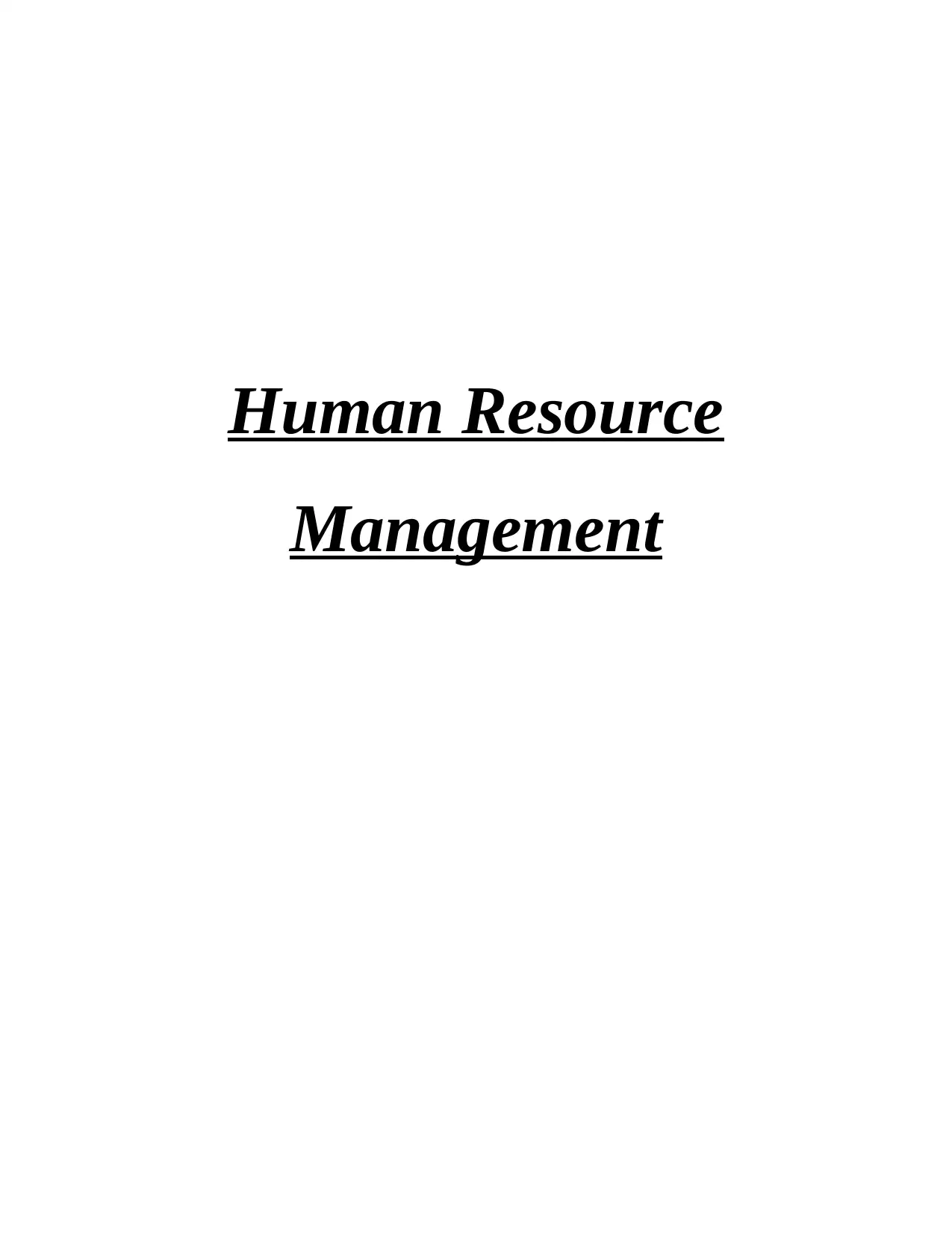
Human Resource
Management
Management
Paraphrase This Document
Need a fresh take? Get an instant paraphrase of this document with our AI Paraphraser
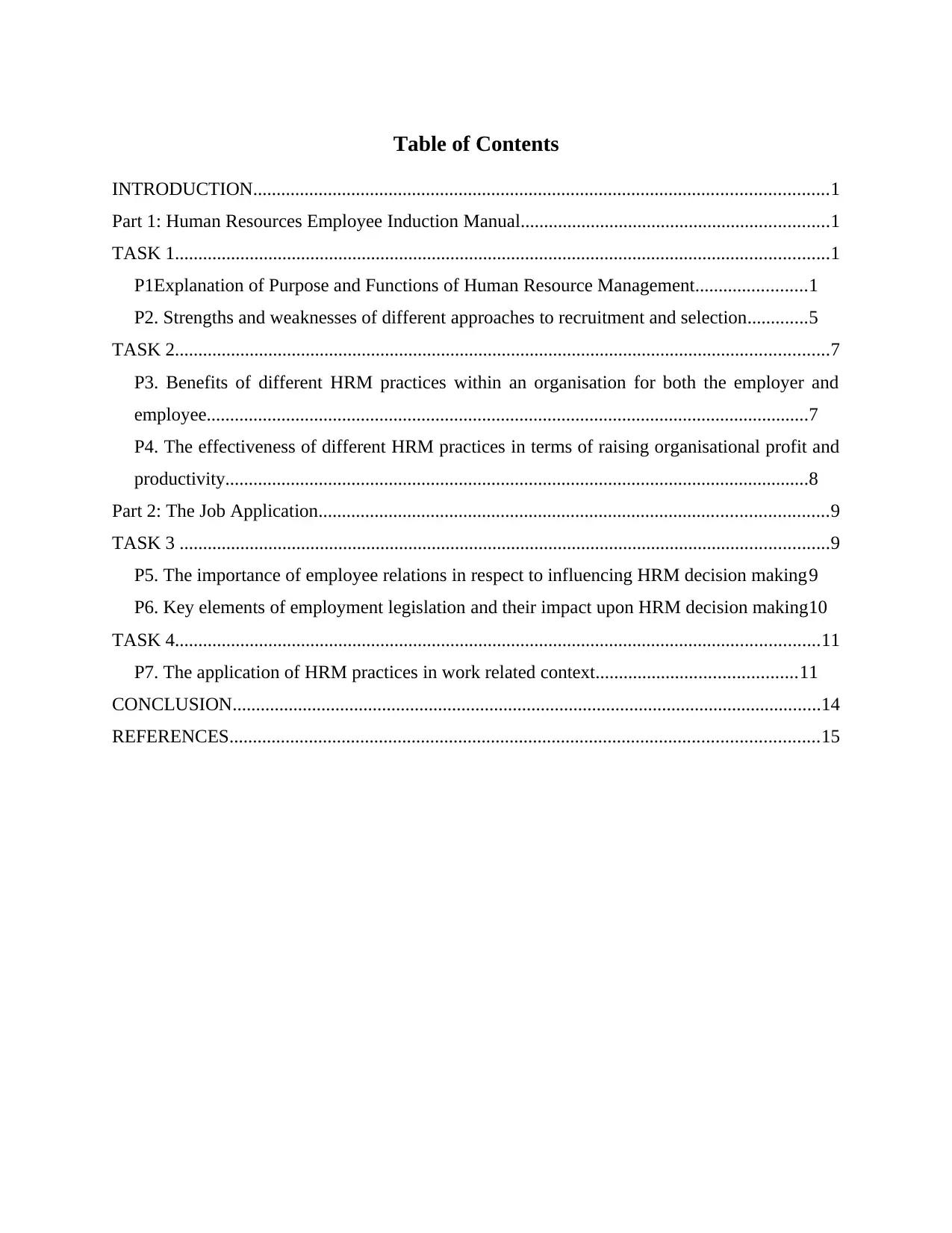
Table of Contents
INTRODUCTION...........................................................................................................................1
Part 1: Human Resources Employee Induction Manual..................................................................1
TASK 1............................................................................................................................................1
P1Explanation of Purpose and Functions of Human Resource Management........................1
P2. Strengths and weaknesses of different approaches to recruitment and selection.............5
TASK 2............................................................................................................................................7
P3. Benefits of different HRM practices within an organisation for both the employer and
employee.................................................................................................................................7
P4. The effectiveness of different HRM practices in terms of raising organisational profit and
productivity.............................................................................................................................8
Part 2: The Job Application.............................................................................................................9
TASK 3 ...........................................................................................................................................9
P5. The importance of employee relations in respect to influencing HRM decision making9
P6. Key elements of employment legislation and their impact upon HRM decision making10
TASK 4..........................................................................................................................................11
P7. The application of HRM practices in work related context...........................................11
CONCLUSION..............................................................................................................................14
REFERENCES..............................................................................................................................15
INTRODUCTION...........................................................................................................................1
Part 1: Human Resources Employee Induction Manual..................................................................1
TASK 1............................................................................................................................................1
P1Explanation of Purpose and Functions of Human Resource Management........................1
P2. Strengths and weaknesses of different approaches to recruitment and selection.............5
TASK 2............................................................................................................................................7
P3. Benefits of different HRM practices within an organisation for both the employer and
employee.................................................................................................................................7
P4. The effectiveness of different HRM practices in terms of raising organisational profit and
productivity.............................................................................................................................8
Part 2: The Job Application.............................................................................................................9
TASK 3 ...........................................................................................................................................9
P5. The importance of employee relations in respect to influencing HRM decision making9
P6. Key elements of employment legislation and their impact upon HRM decision making10
TASK 4..........................................................................................................................................11
P7. The application of HRM practices in work related context...........................................11
CONCLUSION..............................................................................................................................14
REFERENCES..............................................................................................................................15
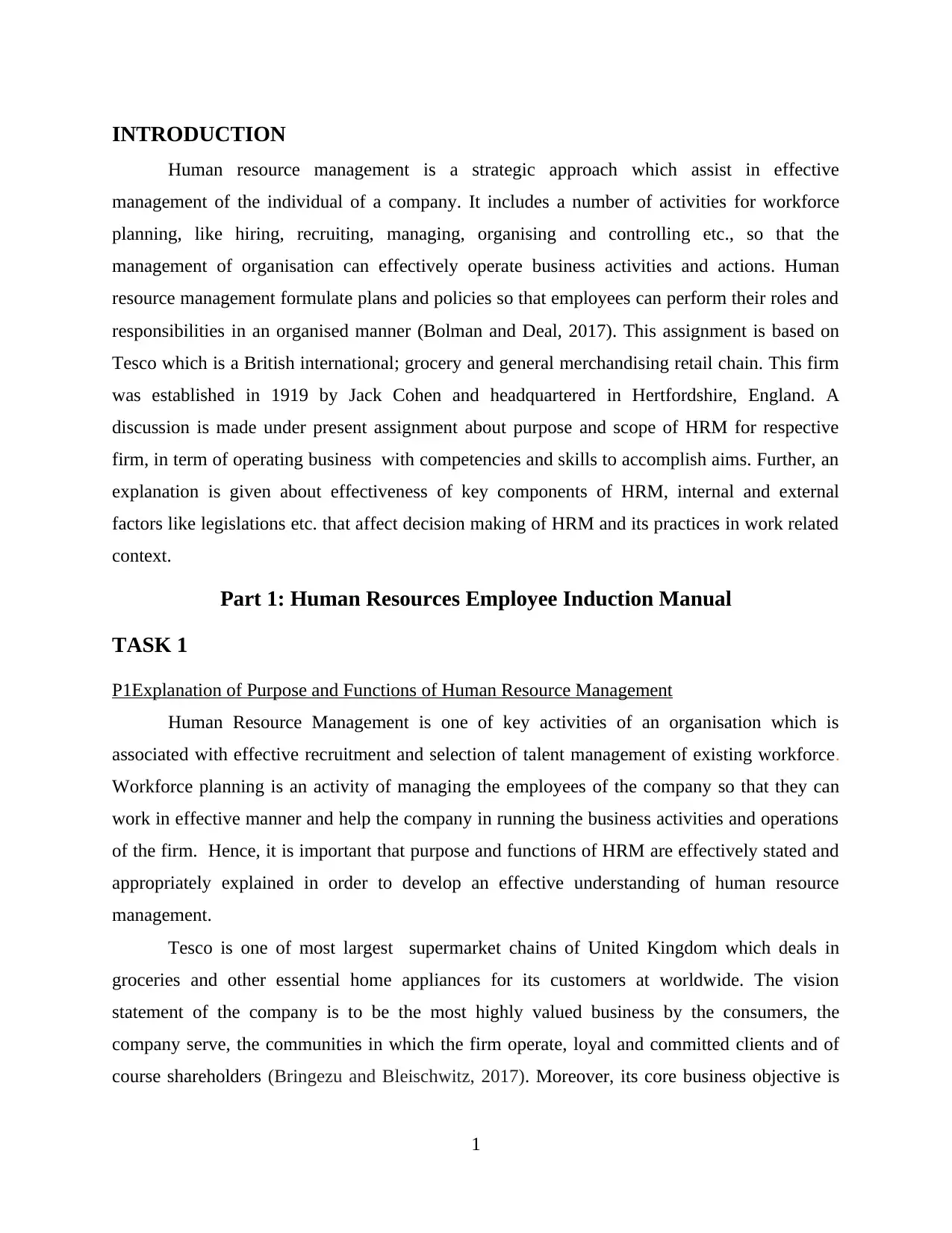
INTRODUCTION
Human resource management is a strategic approach which assist in effective
management of the individual of a company. It includes a number of activities for workforce
planning, like hiring, recruiting, managing, organising and controlling etc., so that the
management of organisation can effectively operate business activities and actions. Human
resource management formulate plans and policies so that employees can perform their roles and
responsibilities in an organised manner (Bolman and Deal, 2017). This assignment is based on
Tesco which is a British international; grocery and general merchandising retail chain. This firm
was established in 1919 by Jack Cohen and headquartered in Hertfordshire, England. A
discussion is made under present assignment about purpose and scope of HRM for respective
firm, in term of operating business with competencies and skills to accomplish aims. Further, an
explanation is given about effectiveness of key components of HRM, internal and external
factors like legislations etc. that affect decision making of HRM and its practices in work related
context.
Part 1: Human Resources Employee Induction Manual
TASK 1
P1Explanation of Purpose and Functions of Human Resource Management
Human Resource Management is one of key activities of an organisation which is
associated with effective recruitment and selection of talent management of existing workforce.
Workforce planning is an activity of managing the employees of the company so that they can
work in effective manner and help the company in running the business activities and operations
of the firm. Hence, it is important that purpose and functions of HRM are effectively stated and
appropriately explained in order to develop an effective understanding of human resource
management.
Tesco is one of most largest supermarket chains of United Kingdom which deals in
groceries and other essential home appliances for its customers at worldwide. The vision
statement of the company is to be the most highly valued business by the consumers, the
company serve, the communities in which the firm operate, loyal and committed clients and of
course shareholders (Bringezu and Bleischwitz, 2017). Moreover, its core business objective is
1
Human resource management is a strategic approach which assist in effective
management of the individual of a company. It includes a number of activities for workforce
planning, like hiring, recruiting, managing, organising and controlling etc., so that the
management of organisation can effectively operate business activities and actions. Human
resource management formulate plans and policies so that employees can perform their roles and
responsibilities in an organised manner (Bolman and Deal, 2017). This assignment is based on
Tesco which is a British international; grocery and general merchandising retail chain. This firm
was established in 1919 by Jack Cohen and headquartered in Hertfordshire, England. A
discussion is made under present assignment about purpose and scope of HRM for respective
firm, in term of operating business with competencies and skills to accomplish aims. Further, an
explanation is given about effectiveness of key components of HRM, internal and external
factors like legislations etc. that affect decision making of HRM and its practices in work related
context.
Part 1: Human Resources Employee Induction Manual
TASK 1
P1Explanation of Purpose and Functions of Human Resource Management
Human Resource Management is one of key activities of an organisation which is
associated with effective recruitment and selection of talent management of existing workforce.
Workforce planning is an activity of managing the employees of the company so that they can
work in effective manner and help the company in running the business activities and operations
of the firm. Hence, it is important that purpose and functions of HRM are effectively stated and
appropriately explained in order to develop an effective understanding of human resource
management.
Tesco is one of most largest supermarket chains of United Kingdom which deals in
groceries and other essential home appliances for its customers at worldwide. The vision
statement of the company is to be the most highly valued business by the consumers, the
company serve, the communities in which the firm operate, loyal and committed clients and of
course shareholders (Bringezu and Bleischwitz, 2017). Moreover, its core business objective is
1
⊘ This is a preview!⊘
Do you want full access?
Subscribe today to unlock all pages.

Trusted by 1+ million students worldwide
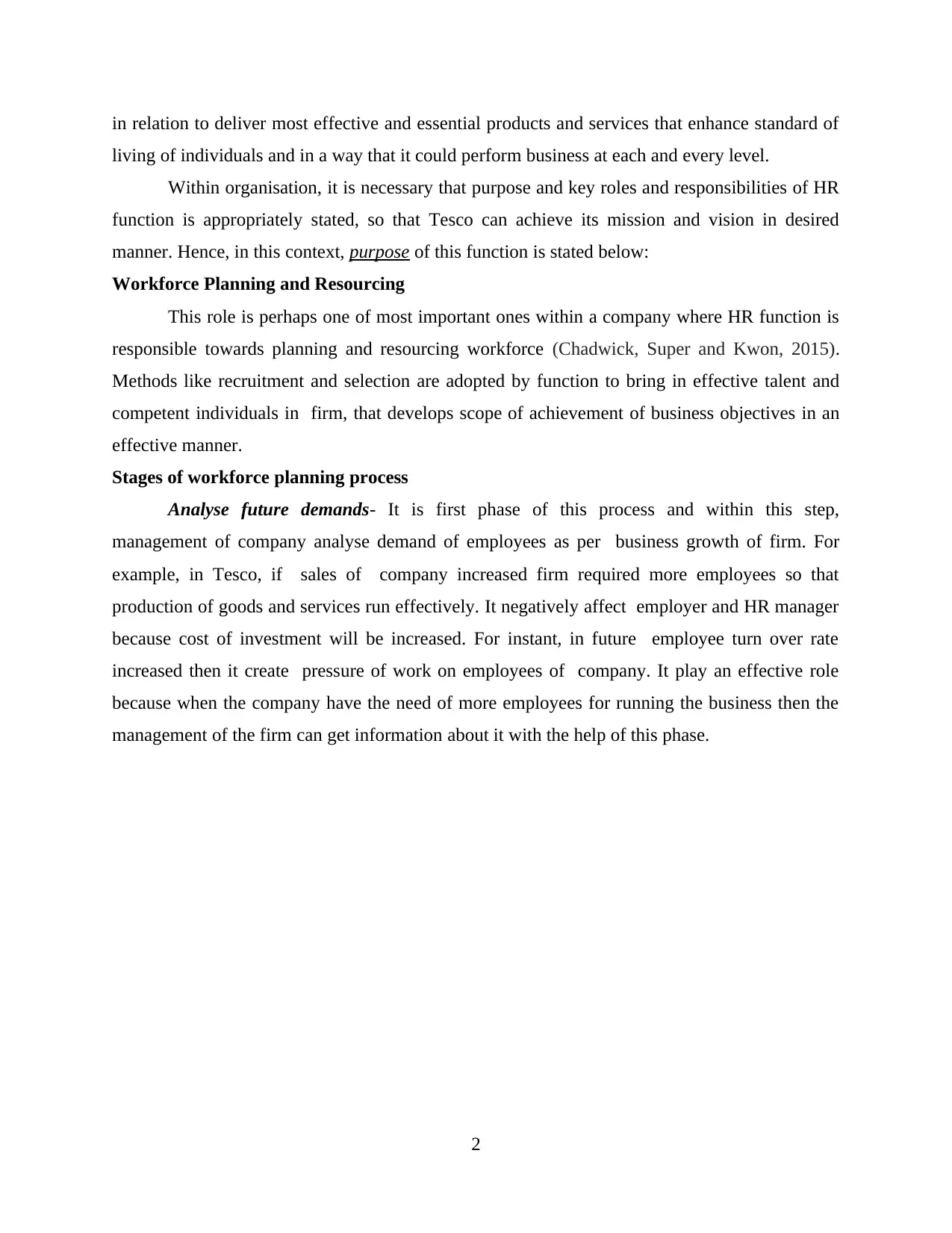
in relation to deliver most effective and essential products and services that enhance standard of
living of individuals and in a way that it could perform business at each and every level.
Within organisation, it is necessary that purpose and key roles and responsibilities of HR
function is appropriately stated, so that Tesco can achieve its mission and vision in desired
manner. Hence, in this context, purpose of this function is stated below:
Workforce Planning and Resourcing
This role is perhaps one of most important ones within a company where HR function is
responsible towards planning and resourcing workforce (Chadwick, Super and Kwon, 2015).
Methods like recruitment and selection are adopted by function to bring in effective talent and
competent individuals in firm, that develops scope of achievement of business objectives in an
effective manner.
Stages of workforce planning process
Analyse future demands- It is first phase of this process and within this step,
management of company analyse demand of employees as per business growth of firm. For
example, in Tesco, if sales of company increased firm required more employees so that
production of goods and services run effectively. It negatively affect employer and HR manager
because cost of investment will be increased. For instant, in future employee turn over rate
increased then it create pressure of work on employees of company. It play an effective role
because when the company have the need of more employees for running the business then the
management of the firm can get information about it with the help of this phase.
2
living of individuals and in a way that it could perform business at each and every level.
Within organisation, it is necessary that purpose and key roles and responsibilities of HR
function is appropriately stated, so that Tesco can achieve its mission and vision in desired
manner. Hence, in this context, purpose of this function is stated below:
Workforce Planning and Resourcing
This role is perhaps one of most important ones within a company where HR function is
responsible towards planning and resourcing workforce (Chadwick, Super and Kwon, 2015).
Methods like recruitment and selection are adopted by function to bring in effective talent and
competent individuals in firm, that develops scope of achievement of business objectives in an
effective manner.
Stages of workforce planning process
Analyse future demands- It is first phase of this process and within this step,
management of company analyse demand of employees as per business growth of firm. For
example, in Tesco, if sales of company increased firm required more employees so that
production of goods and services run effectively. It negatively affect employer and HR manager
because cost of investment will be increased. For instant, in future employee turn over rate
increased then it create pressure of work on employees of company. It play an effective role
because when the company have the need of more employees for running the business then the
management of the firm can get information about it with the help of this phase.
2
Paraphrase This Document
Need a fresh take? Get an instant paraphrase of this document with our AI Paraphraser
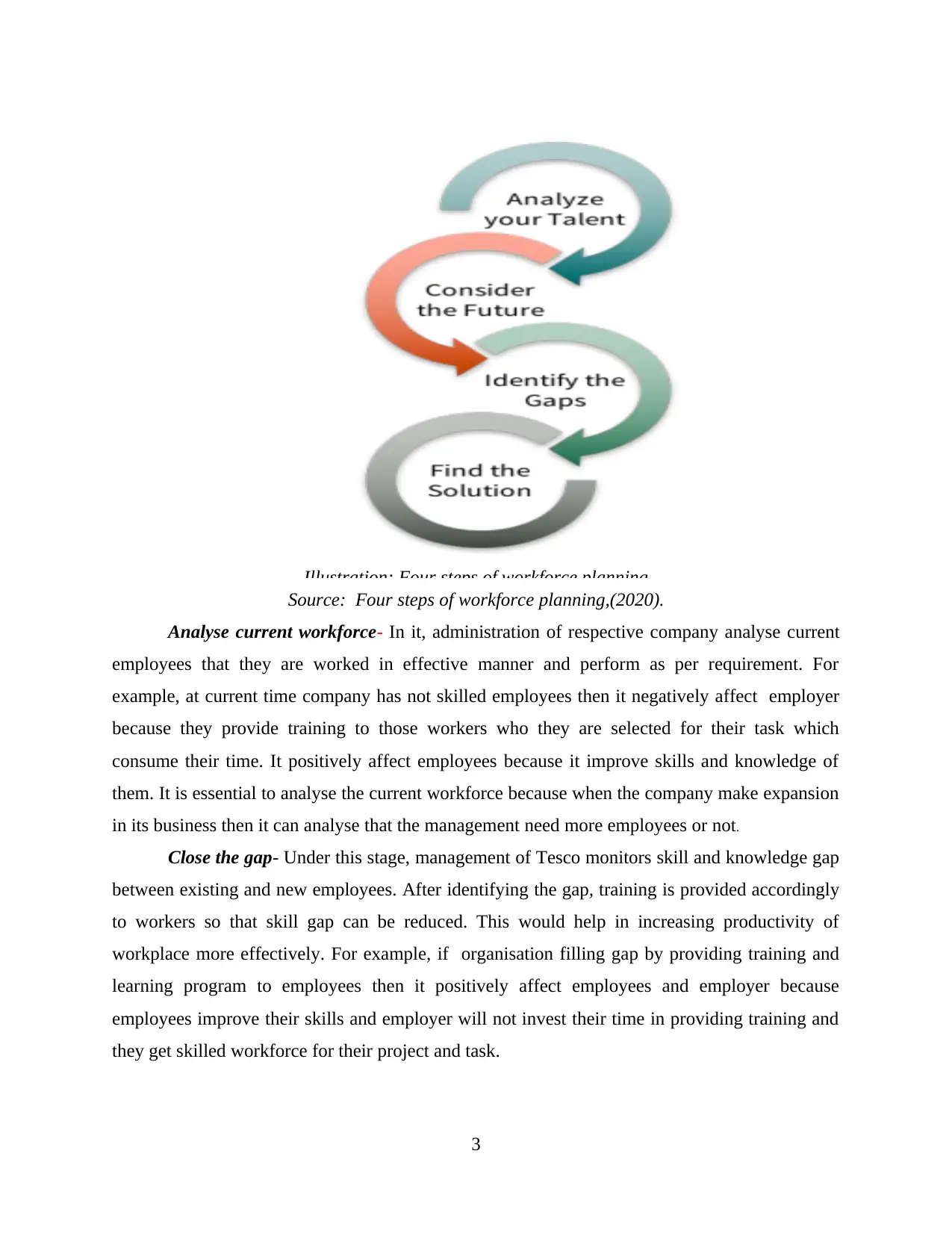
Source: Four steps of workforce planning,(2020).
Analyse current workforce- In it, administration of respective company analyse current
employees that they are worked in effective manner and perform as per requirement. For
example, at current time company has not skilled employees then it negatively affect employer
because they provide training to those workers who they are selected for their task which
consume their time. It positively affect employees because it improve skills and knowledge of
them. It is essential to analyse the current workforce because when the company make expansion
in its business then it can analyse that the management need more employees or not.
Close the gap- Under this stage, management of Tesco monitors skill and knowledge gap
between existing and new employees. After identifying the gap, training is provided accordingly
to workers so that skill gap can be reduced. This would help in increasing productivity of
workplace more effectively. For example, if organisation filling gap by providing training and
learning program to employees then it positively affect employees and employer because
employees improve their skills and employer will not invest their time in providing training and
they get skilled workforce for their project and task.
3
Illustration: Four steps of workforce planning
Analyse current workforce- In it, administration of respective company analyse current
employees that they are worked in effective manner and perform as per requirement. For
example, at current time company has not skilled employees then it negatively affect employer
because they provide training to those workers who they are selected for their task which
consume their time. It positively affect employees because it improve skills and knowledge of
them. It is essential to analyse the current workforce because when the company make expansion
in its business then it can analyse that the management need more employees or not.
Close the gap- Under this stage, management of Tesco monitors skill and knowledge gap
between existing and new employees. After identifying the gap, training is provided accordingly
to workers so that skill gap can be reduced. This would help in increasing productivity of
workplace more effectively. For example, if organisation filling gap by providing training and
learning program to employees then it positively affect employees and employer because
employees improve their skills and employer will not invest their time in providing training and
they get skilled workforce for their project and task.
3
Illustration: Four steps of workforce planning
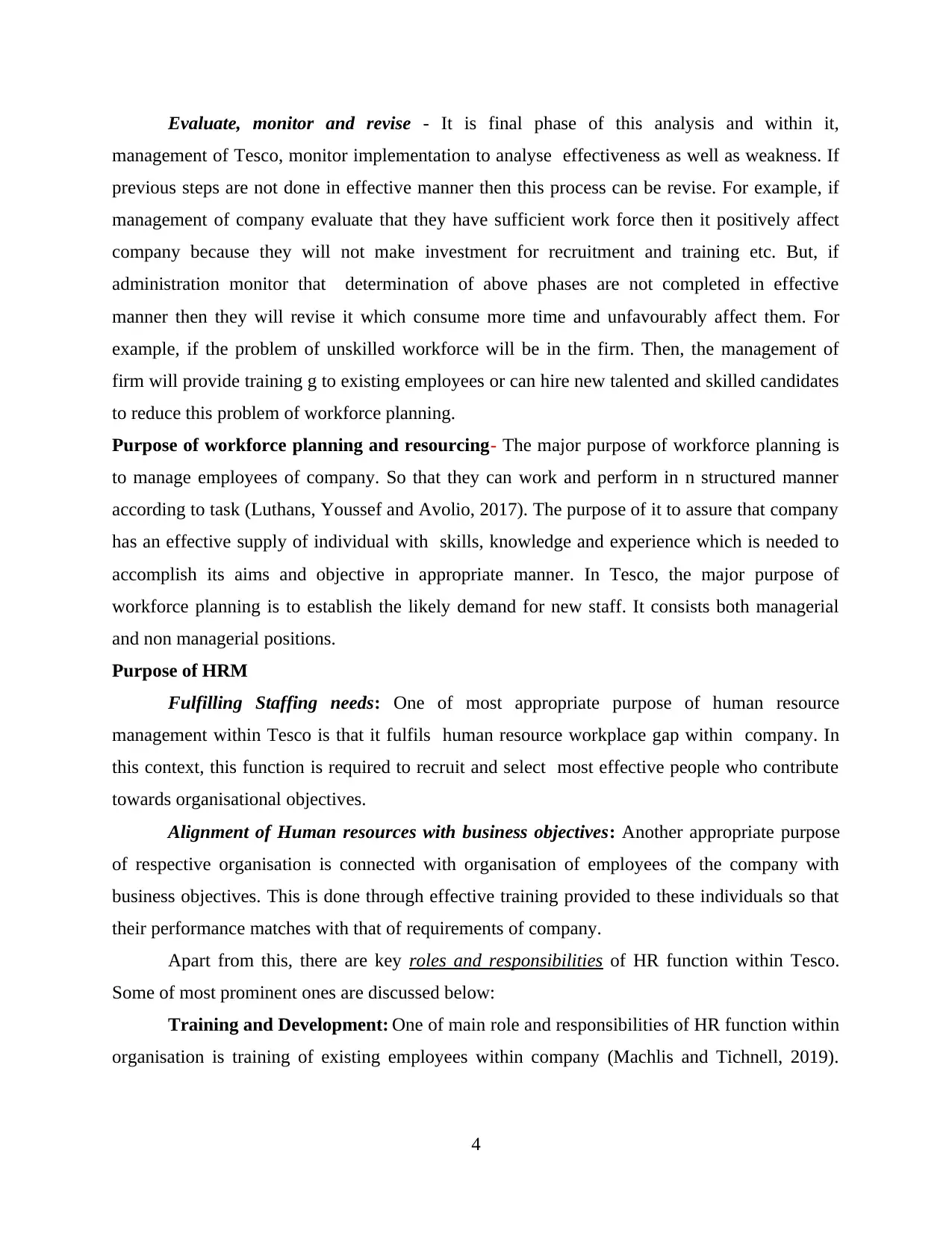
Evaluate, monitor and revise - It is final phase of this analysis and within it,
management of Tesco, monitor implementation to analyse effectiveness as well as weakness. If
previous steps are not done in effective manner then this process can be revise. For example, if
management of company evaluate that they have sufficient work force then it positively affect
company because they will not make investment for recruitment and training etc. But, if
administration monitor that determination of above phases are not completed in effective
manner then they will revise it which consume more time and unfavourably affect them. For
example, if the problem of unskilled workforce will be in the firm. Then, the management of
firm will provide training g to existing employees or can hire new talented and skilled candidates
to reduce this problem of workforce planning.
Purpose of workforce planning and resourcing- The major purpose of workforce planning is
to manage employees of company. So that they can work and perform in n structured manner
according to task (Luthans, Youssef and Avolio, 2017). The purpose of it to assure that company
has an effective supply of individual with skills, knowledge and experience which is needed to
accomplish its aims and objective in appropriate manner. In Tesco, the major purpose of
workforce planning is to establish the likely demand for new staff. It consists both managerial
and non managerial positions.
Purpose of HRM
Fulfilling Staffing needs: One of most appropriate purpose of human resource
management within Tesco is that it fulfils human resource workplace gap within company. In
this context, this function is required to recruit and select most effective people who contribute
towards organisational objectives.
Alignment of Human resources with business objectives: Another appropriate purpose
of respective organisation is connected with organisation of employees of the company with
business objectives. This is done through effective training provided to these individuals so that
their performance matches with that of requirements of company.
Apart from this, there are key roles and responsibilities of HR function within Tesco.
Some of most prominent ones are discussed below:
Training and Development: One of main role and responsibilities of HR function within
organisation is training of existing employees within company (Machlis and Tichnell, 2019).
4
management of Tesco, monitor implementation to analyse effectiveness as well as weakness. If
previous steps are not done in effective manner then this process can be revise. For example, if
management of company evaluate that they have sufficient work force then it positively affect
company because they will not make investment for recruitment and training etc. But, if
administration monitor that determination of above phases are not completed in effective
manner then they will revise it which consume more time and unfavourably affect them. For
example, if the problem of unskilled workforce will be in the firm. Then, the management of
firm will provide training g to existing employees or can hire new talented and skilled candidates
to reduce this problem of workforce planning.
Purpose of workforce planning and resourcing- The major purpose of workforce planning is
to manage employees of company. So that they can work and perform in n structured manner
according to task (Luthans, Youssef and Avolio, 2017). The purpose of it to assure that company
has an effective supply of individual with skills, knowledge and experience which is needed to
accomplish its aims and objective in appropriate manner. In Tesco, the major purpose of
workforce planning is to establish the likely demand for new staff. It consists both managerial
and non managerial positions.
Purpose of HRM
Fulfilling Staffing needs: One of most appropriate purpose of human resource
management within Tesco is that it fulfils human resource workplace gap within company. In
this context, this function is required to recruit and select most effective people who contribute
towards organisational objectives.
Alignment of Human resources with business objectives: Another appropriate purpose
of respective organisation is connected with organisation of employees of the company with
business objectives. This is done through effective training provided to these individuals so that
their performance matches with that of requirements of company.
Apart from this, there are key roles and responsibilities of HR function within Tesco.
Some of most prominent ones are discussed below:
Training and Development: One of main role and responsibilities of HR function within
organisation is training of existing employees within company (Machlis and Tichnell, 2019).
4
⊘ This is a preview!⊘
Do you want full access?
Subscribe today to unlock all pages.

Trusted by 1+ million students worldwide
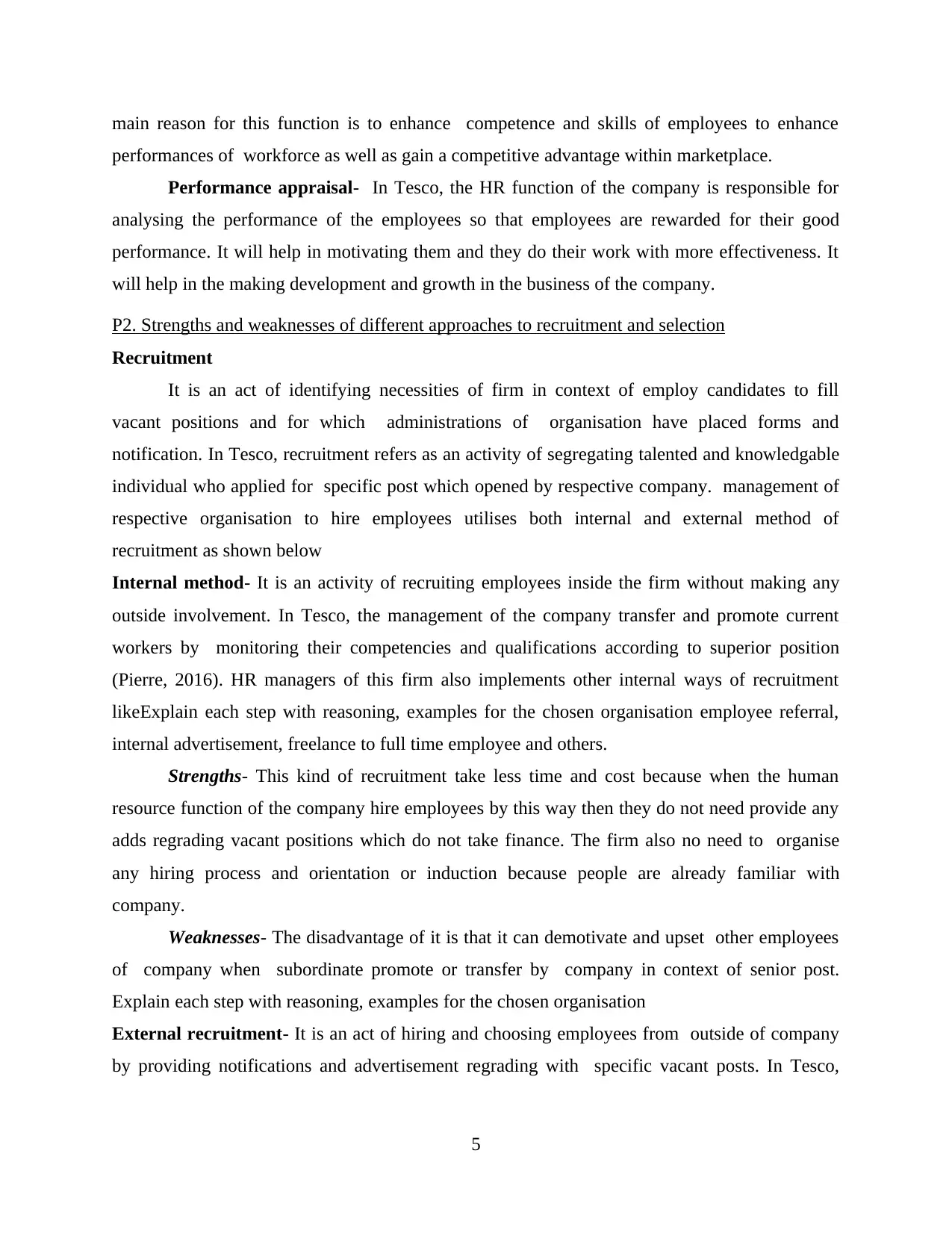
main reason for this function is to enhance competence and skills of employees to enhance
performances of workforce as well as gain a competitive advantage within marketplace.
Performance appraisal- In Tesco, the HR function of the company is responsible for
analysing the performance of the employees so that employees are rewarded for their good
performance. It will help in motivating them and they do their work with more effectiveness. It
will help in the making development and growth in the business of the company.
P2. Strengths and weaknesses of different approaches to recruitment and selection
Recruitment
It is an act of identifying necessities of firm in context of employ candidates to fill
vacant positions and for which administrations of organisation have placed forms and
notification. In Tesco, recruitment refers as an activity of segregating talented and knowledgable
individual who applied for specific post which opened by respective company. management of
respective organisation to hire employees utilises both internal and external method of
recruitment as shown below
Internal method- It is an activity of recruiting employees inside the firm without making any
outside involvement. In Tesco, the management of the company transfer and promote current
workers by monitoring their competencies and qualifications according to superior position
(Pierre, 2016). HR managers of this firm also implements other internal ways of recruitment
likeExplain each step with reasoning, examples for the chosen organisation employee referral,
internal advertisement, freelance to full time employee and others.
Strengths- This kind of recruitment take less time and cost because when the human
resource function of the company hire employees by this way then they do not need provide any
adds regrading vacant positions which do not take finance. The firm also no need to organise
any hiring process and orientation or induction because people are already familiar with
company.
Weaknesses- The disadvantage of it is that it can demotivate and upset other employees
of company when subordinate promote or transfer by company in context of senior post.
Explain each step with reasoning, examples for the chosen organisation
External recruitment- It is an act of hiring and choosing employees from outside of company
by providing notifications and advertisement regrading with specific vacant posts. In Tesco,
5
performances of workforce as well as gain a competitive advantage within marketplace.
Performance appraisal- In Tesco, the HR function of the company is responsible for
analysing the performance of the employees so that employees are rewarded for their good
performance. It will help in motivating them and they do their work with more effectiveness. It
will help in the making development and growth in the business of the company.
P2. Strengths and weaknesses of different approaches to recruitment and selection
Recruitment
It is an act of identifying necessities of firm in context of employ candidates to fill
vacant positions and for which administrations of organisation have placed forms and
notification. In Tesco, recruitment refers as an activity of segregating talented and knowledgable
individual who applied for specific post which opened by respective company. management of
respective organisation to hire employees utilises both internal and external method of
recruitment as shown below
Internal method- It is an activity of recruiting employees inside the firm without making any
outside involvement. In Tesco, the management of the company transfer and promote current
workers by monitoring their competencies and qualifications according to superior position
(Pierre, 2016). HR managers of this firm also implements other internal ways of recruitment
likeExplain each step with reasoning, examples for the chosen organisation employee referral,
internal advertisement, freelance to full time employee and others.
Strengths- This kind of recruitment take less time and cost because when the human
resource function of the company hire employees by this way then they do not need provide any
adds regrading vacant positions which do not take finance. The firm also no need to organise
any hiring process and orientation or induction because people are already familiar with
company.
Weaknesses- The disadvantage of it is that it can demotivate and upset other employees
of company when subordinate promote or transfer by company in context of senior post.
Explain each step with reasoning, examples for the chosen organisation
External recruitment- It is an act of hiring and choosing employees from outside of company
by providing notifications and advertisement regrading with specific vacant posts. In Tesco,
5
Paraphrase This Document
Need a fresh take? Get an instant paraphrase of this document with our AI Paraphraser
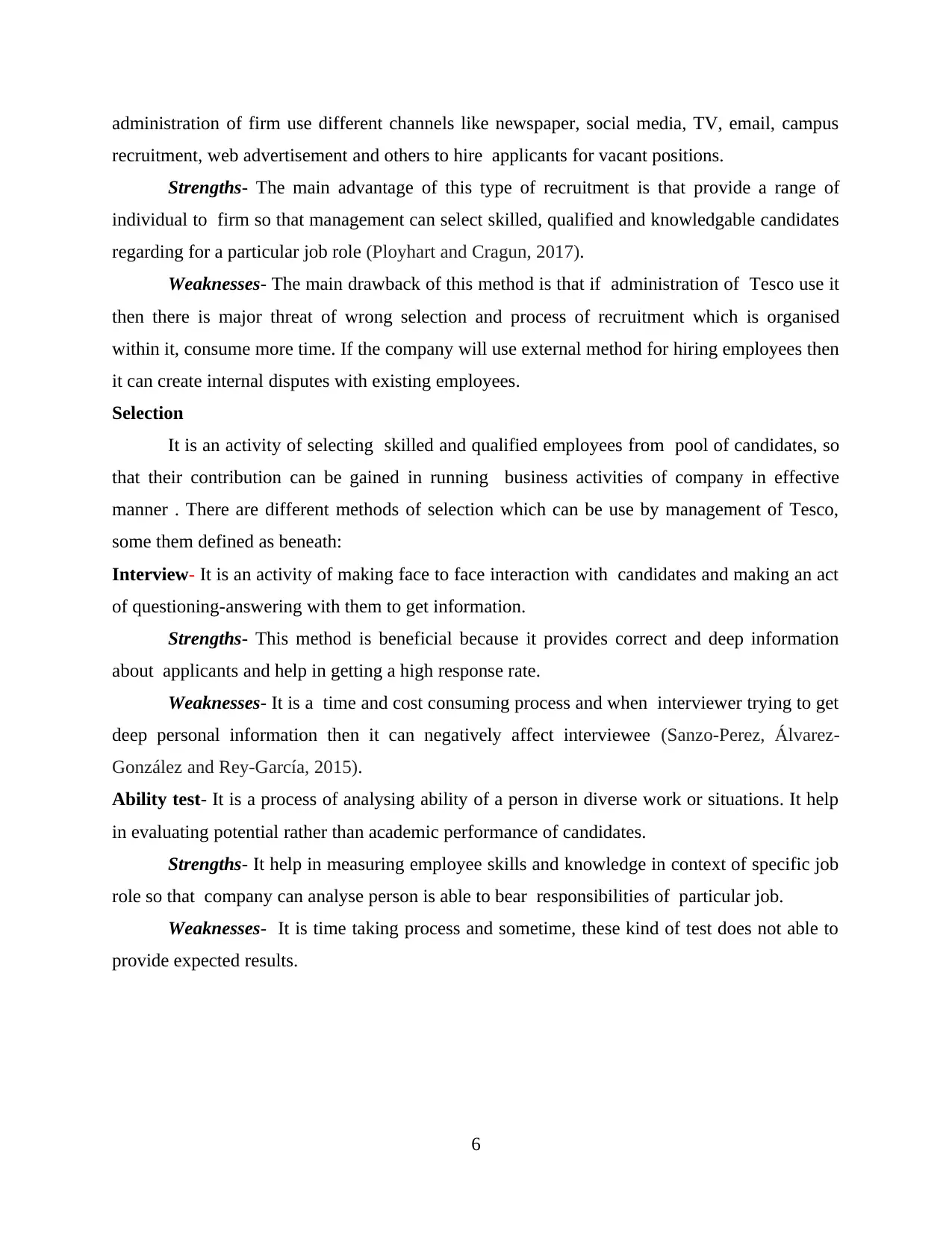
administration of firm use different channels like newspaper, social media, TV, email, campus
recruitment, web advertisement and others to hire applicants for vacant positions.
Strengths- The main advantage of this type of recruitment is that provide a range of
individual to firm so that management can select skilled, qualified and knowledgable candidates
regarding for a particular job role (Ployhart and Cragun, 2017).
Weaknesses- The main drawback of this method is that if administration of Tesco use it
then there is major threat of wrong selection and process of recruitment which is organised
within it, consume more time. If the company will use external method for hiring employees then
it can create internal disputes with existing employees.
Selection
It is an activity of selecting skilled and qualified employees from pool of candidates, so
that their contribution can be gained in running business activities of company in effective
manner . There are different methods of selection which can be use by management of Tesco,
some them defined as beneath:
Interview- It is an activity of making face to face interaction with candidates and making an act
of questioning-answering with them to get information.
Strengths- This method is beneficial because it provides correct and deep information
about applicants and help in getting a high response rate.
Weaknesses- It is a time and cost consuming process and when interviewer trying to get
deep personal information then it can negatively affect interviewee (Sanzo-Perez, Álvarez-
González and Rey-García, 2015).
Ability test- It is a process of analysing ability of a person in diverse work or situations. It help
in evaluating potential rather than academic performance of candidates.
Strengths- It help in measuring employee skills and knowledge in context of specific job
role so that company can analyse person is able to bear responsibilities of particular job.
Weaknesses- It is time taking process and sometime, these kind of test does not able to
provide expected results.
6
recruitment, web advertisement and others to hire applicants for vacant positions.
Strengths- The main advantage of this type of recruitment is that provide a range of
individual to firm so that management can select skilled, qualified and knowledgable candidates
regarding for a particular job role (Ployhart and Cragun, 2017).
Weaknesses- The main drawback of this method is that if administration of Tesco use it
then there is major threat of wrong selection and process of recruitment which is organised
within it, consume more time. If the company will use external method for hiring employees then
it can create internal disputes with existing employees.
Selection
It is an activity of selecting skilled and qualified employees from pool of candidates, so
that their contribution can be gained in running business activities of company in effective
manner . There are different methods of selection which can be use by management of Tesco,
some them defined as beneath:
Interview- It is an activity of making face to face interaction with candidates and making an act
of questioning-answering with them to get information.
Strengths- This method is beneficial because it provides correct and deep information
about applicants and help in getting a high response rate.
Weaknesses- It is a time and cost consuming process and when interviewer trying to get
deep personal information then it can negatively affect interviewee (Sanzo-Perez, Álvarez-
González and Rey-García, 2015).
Ability test- It is a process of analysing ability of a person in diverse work or situations. It help
in evaluating potential rather than academic performance of candidates.
Strengths- It help in measuring employee skills and knowledge in context of specific job
role so that company can analyse person is able to bear responsibilities of particular job.
Weaknesses- It is time taking process and sometime, these kind of test does not able to
provide expected results.
6
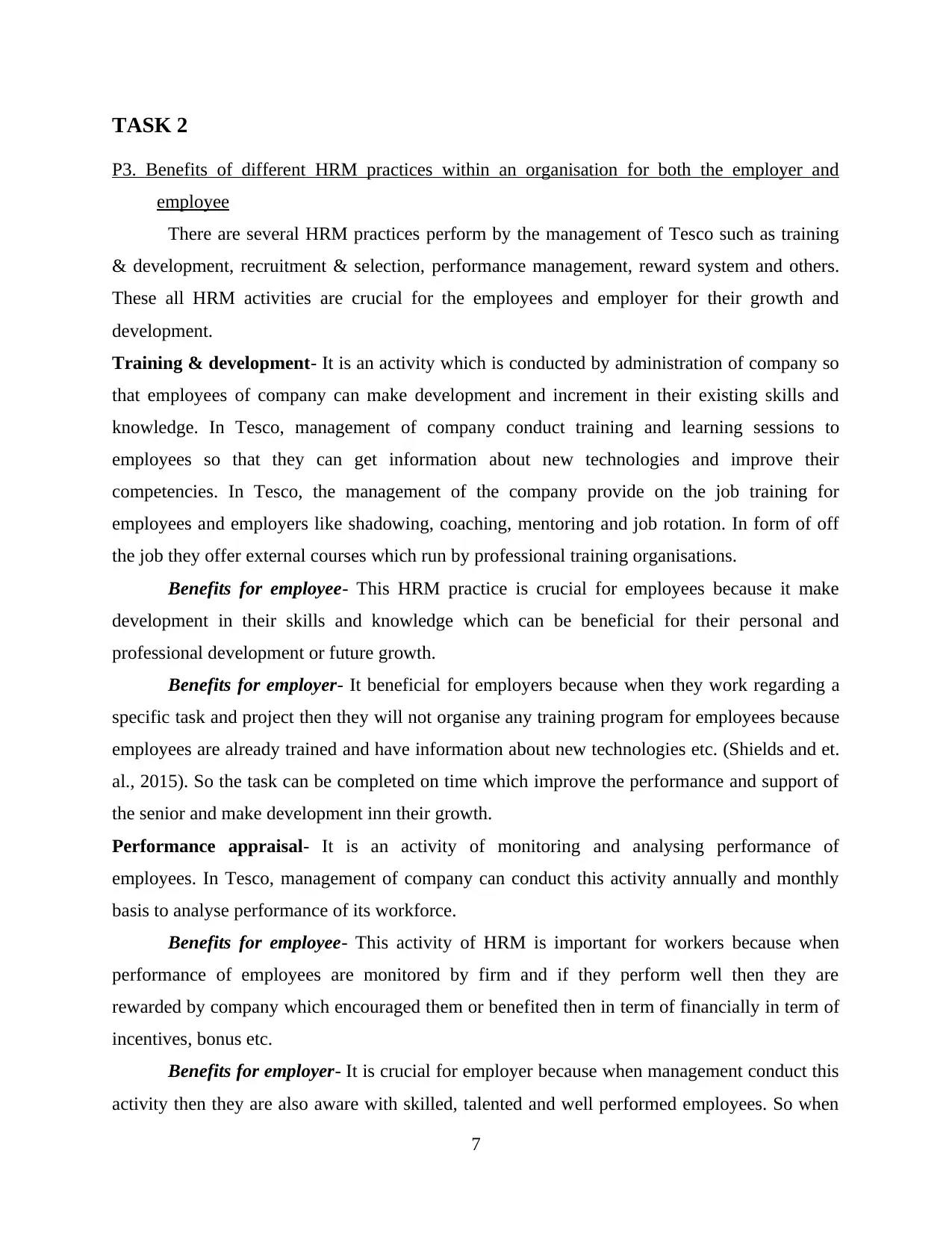
TASK 2
P3. Benefits of different HRM practices within an organisation for both the employer and
employee
There are several HRM practices perform by the management of Tesco such as training
& development, recruitment & selection, performance management, reward system and others.
These all HRM activities are crucial for the employees and employer for their growth and
development.
Training & development- It is an activity which is conducted by administration of company so
that employees of company can make development and increment in their existing skills and
knowledge. In Tesco, management of company conduct training and learning sessions to
employees so that they can get information about new technologies and improve their
competencies. In Tesco, the management of the company provide on the job training for
employees and employers like shadowing, coaching, mentoring and job rotation. In form of off
the job they offer external courses which run by professional training organisations.
Benefits for employee- This HRM practice is crucial for employees because it make
development in their skills and knowledge which can be beneficial for their personal and
professional development or future growth.
Benefits for employer- It beneficial for employers because when they work regarding a
specific task and project then they will not organise any training program for employees because
employees are already trained and have information about new technologies etc. (Shields and et.
al., 2015). So the task can be completed on time which improve the performance and support of
the senior and make development inn their growth.
Performance appraisal- It is an activity of monitoring and analysing performance of
employees. In Tesco, management of company can conduct this activity annually and monthly
basis to analyse performance of its workforce.
Benefits for employee- This activity of HRM is important for workers because when
performance of employees are monitored by firm and if they perform well then they are
rewarded by company which encouraged them or benefited then in term of financially in term of
incentives, bonus etc.
Benefits for employer- It is crucial for employer because when management conduct this
activity then they are also aware with skilled, talented and well performed employees. So when
7
P3. Benefits of different HRM practices within an organisation for both the employer and
employee
There are several HRM practices perform by the management of Tesco such as training
& development, recruitment & selection, performance management, reward system and others.
These all HRM activities are crucial for the employees and employer for their growth and
development.
Training & development- It is an activity which is conducted by administration of company so
that employees of company can make development and increment in their existing skills and
knowledge. In Tesco, management of company conduct training and learning sessions to
employees so that they can get information about new technologies and improve their
competencies. In Tesco, the management of the company provide on the job training for
employees and employers like shadowing, coaching, mentoring and job rotation. In form of off
the job they offer external courses which run by professional training organisations.
Benefits for employee- This HRM practice is crucial for employees because it make
development in their skills and knowledge which can be beneficial for their personal and
professional development or future growth.
Benefits for employer- It beneficial for employers because when they work regarding a
specific task and project then they will not organise any training program for employees because
employees are already trained and have information about new technologies etc. (Shields and et.
al., 2015). So the task can be completed on time which improve the performance and support of
the senior and make development inn their growth.
Performance appraisal- It is an activity of monitoring and analysing performance of
employees. In Tesco, management of company can conduct this activity annually and monthly
basis to analyse performance of its workforce.
Benefits for employee- This activity of HRM is important for workers because when
performance of employees are monitored by firm and if they perform well then they are
rewarded by company which encouraged them or benefited then in term of financially in term of
incentives, bonus etc.
Benefits for employer- It is crucial for employer because when management conduct this
activity then they are also aware with skilled, talented and well performed employees. So when
7
⊘ This is a preview!⊘
Do you want full access?
Subscribe today to unlock all pages.

Trusted by 1+ million students worldwide
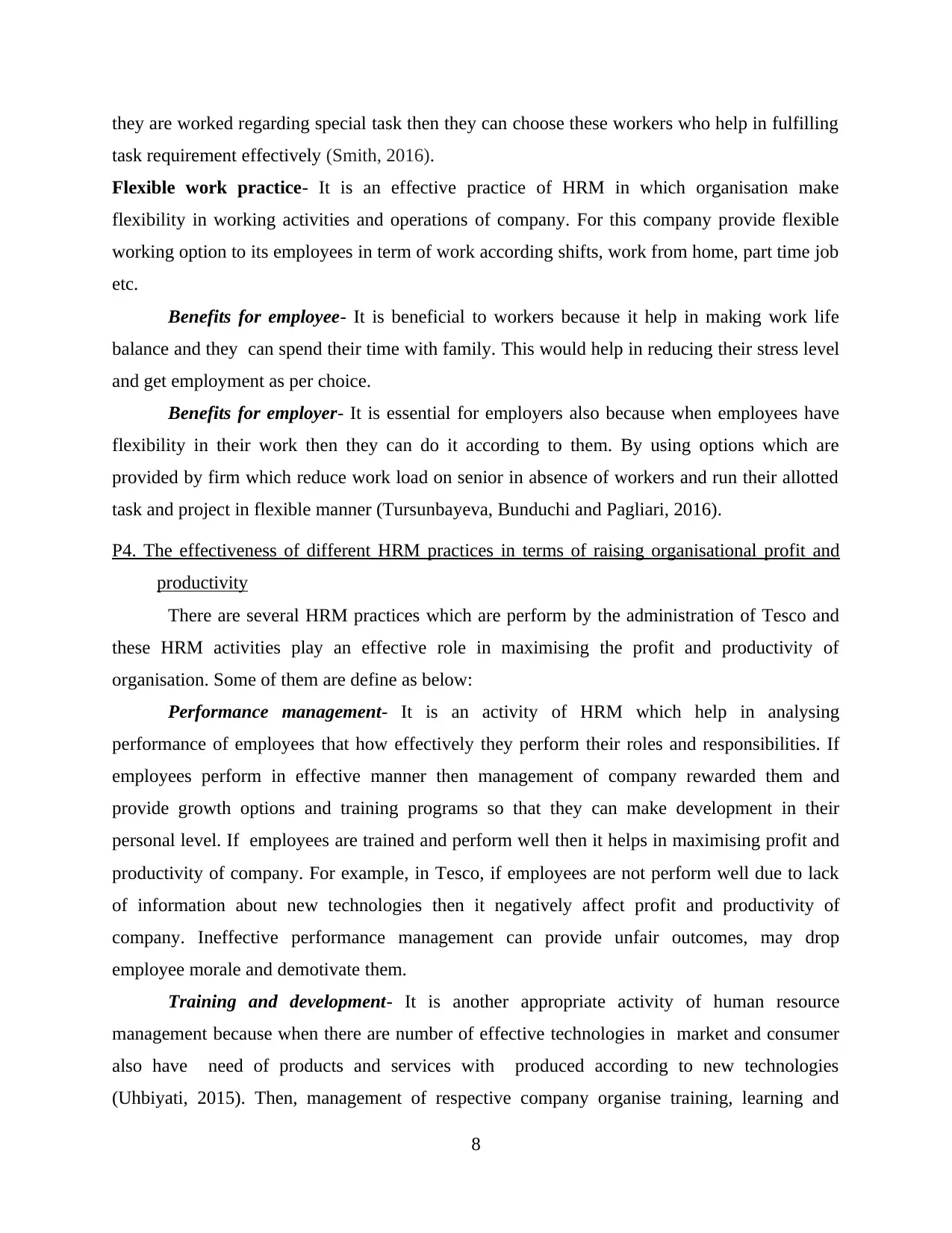
they are worked regarding special task then they can choose these workers who help in fulfilling
task requirement effectively (Smith, 2016).
Flexible work practice- It is an effective practice of HRM in which organisation make
flexibility in working activities and operations of company. For this company provide flexible
working option to its employees in term of work according shifts, work from home, part time job
etc.
Benefits for employee- It is beneficial to workers because it help in making work life
balance and they can spend their time with family. This would help in reducing their stress level
and get employment as per choice.
Benefits for employer- It is essential for employers also because when employees have
flexibility in their work then they can do it according to them. By using options which are
provided by firm which reduce work load on senior in absence of workers and run their allotted
task and project in flexible manner (Tursunbayeva, Bunduchi and Pagliari, 2016).
P4. The effectiveness of different HRM practices in terms of raising organisational profit and
productivity
There are several HRM practices which are perform by the administration of Tesco and
these HRM activities play an effective role in maximising the profit and productivity of
organisation. Some of them are define as below:
Performance management- It is an activity of HRM which help in analysing
performance of employees that how effectively they perform their roles and responsibilities. If
employees perform in effective manner then management of company rewarded them and
provide growth options and training programs so that they can make development in their
personal level. If employees are trained and perform well then it helps in maximising profit and
productivity of company. For example, in Tesco, if employees are not perform well due to lack
of information about new technologies then it negatively affect profit and productivity of
company. Ineffective performance management can provide unfair outcomes, may drop
employee morale and demotivate them.
Training and development- It is another appropriate activity of human resource
management because when there are number of effective technologies in market and consumer
also have need of products and services with produced according to new technologies
(Uhbiyati, 2015). Then, management of respective company organise training, learning and
8
task requirement effectively (Smith, 2016).
Flexible work practice- It is an effective practice of HRM in which organisation make
flexibility in working activities and operations of company. For this company provide flexible
working option to its employees in term of work according shifts, work from home, part time job
etc.
Benefits for employee- It is beneficial to workers because it help in making work life
balance and they can spend their time with family. This would help in reducing their stress level
and get employment as per choice.
Benefits for employer- It is essential for employers also because when employees have
flexibility in their work then they can do it according to them. By using options which are
provided by firm which reduce work load on senior in absence of workers and run their allotted
task and project in flexible manner (Tursunbayeva, Bunduchi and Pagliari, 2016).
P4. The effectiveness of different HRM practices in terms of raising organisational profit and
productivity
There are several HRM practices which are perform by the administration of Tesco and
these HRM activities play an effective role in maximising the profit and productivity of
organisation. Some of them are define as below:
Performance management- It is an activity of HRM which help in analysing
performance of employees that how effectively they perform their roles and responsibilities. If
employees perform in effective manner then management of company rewarded them and
provide growth options and training programs so that they can make development in their
personal level. If employees are trained and perform well then it helps in maximising profit and
productivity of company. For example, in Tesco, if employees are not perform well due to lack
of information about new technologies then it negatively affect profit and productivity of
company. Ineffective performance management can provide unfair outcomes, may drop
employee morale and demotivate them.
Training and development- It is another appropriate activity of human resource
management because when there are number of effective technologies in market and consumer
also have need of products and services with produced according to new technologies
(Uhbiyati, 2015). Then, management of respective company organise training, learning and
8
Paraphrase This Document
Need a fresh take? Get an instant paraphrase of this document with our AI Paraphraser
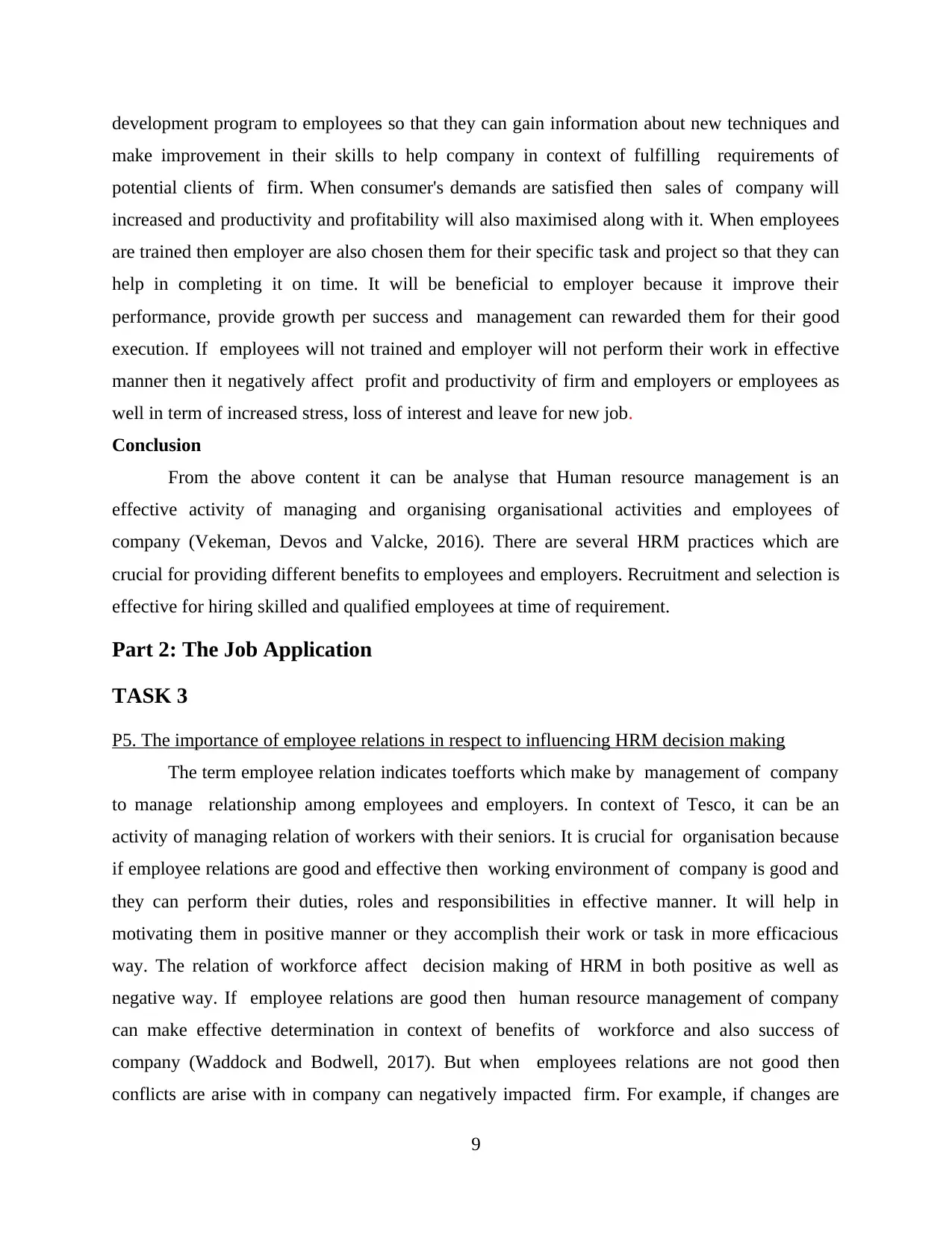
development program to employees so that they can gain information about new techniques and
make improvement in their skills to help company in context of fulfilling requirements of
potential clients of firm. When consumer's demands are satisfied then sales of company will
increased and productivity and profitability will also maximised along with it. When employees
are trained then employer are also chosen them for their specific task and project so that they can
help in completing it on time. It will be beneficial to employer because it improve their
performance, provide growth per success and management can rewarded them for their good
execution. If employees will not trained and employer will not perform their work in effective
manner then it negatively affect profit and productivity of firm and employers or employees as
well in term of increased stress, loss of interest and leave for new job.
Conclusion
From the above content it can be analyse that Human resource management is an
effective activity of managing and organising organisational activities and employees of
company (Vekeman, Devos and Valcke, 2016). There are several HRM practices which are
crucial for providing different benefits to employees and employers. Recruitment and selection is
effective for hiring skilled and qualified employees at time of requirement.
Part 2: The Job Application
TASK 3
P5. The importance of employee relations in respect to influencing HRM decision making
The term employee relation indicates toefforts which make by management of company
to manage relationship among employees and employers. In context of Tesco, it can be an
activity of managing relation of workers with their seniors. It is crucial for organisation because
if employee relations are good and effective then working environment of company is good and
they can perform their duties, roles and responsibilities in effective manner. It will help in
motivating them in positive manner or they accomplish their work or task in more efficacious
way. The relation of workforce affect decision making of HRM in both positive as well as
negative way. If employee relations are good then human resource management of company
can make effective determination in context of benefits of workforce and also success of
company (Waddock and Bodwell, 2017). But when employees relations are not good then
conflicts are arise with in company can negatively impacted firm. For example, if changes are
9
make improvement in their skills to help company in context of fulfilling requirements of
potential clients of firm. When consumer's demands are satisfied then sales of company will
increased and productivity and profitability will also maximised along with it. When employees
are trained then employer are also chosen them for their specific task and project so that they can
help in completing it on time. It will be beneficial to employer because it improve their
performance, provide growth per success and management can rewarded them for their good
execution. If employees will not trained and employer will not perform their work in effective
manner then it negatively affect profit and productivity of firm and employers or employees as
well in term of increased stress, loss of interest and leave for new job.
Conclusion
From the above content it can be analyse that Human resource management is an
effective activity of managing and organising organisational activities and employees of
company (Vekeman, Devos and Valcke, 2016). There are several HRM practices which are
crucial for providing different benefits to employees and employers. Recruitment and selection is
effective for hiring skilled and qualified employees at time of requirement.
Part 2: The Job Application
TASK 3
P5. The importance of employee relations in respect to influencing HRM decision making
The term employee relation indicates toefforts which make by management of company
to manage relationship among employees and employers. In context of Tesco, it can be an
activity of managing relation of workers with their seniors. It is crucial for organisation because
if employee relations are good and effective then working environment of company is good and
they can perform their duties, roles and responsibilities in effective manner. It will help in
motivating them in positive manner or they accomplish their work or task in more efficacious
way. The relation of workforce affect decision making of HRM in both positive as well as
negative way. If employee relations are good then human resource management of company
can make effective determination in context of benefits of workforce and also success of
company (Waddock and Bodwell, 2017). But when employees relations are not good then
conflicts are arise with in company can negatively impacted firm. For example, if changes are
9
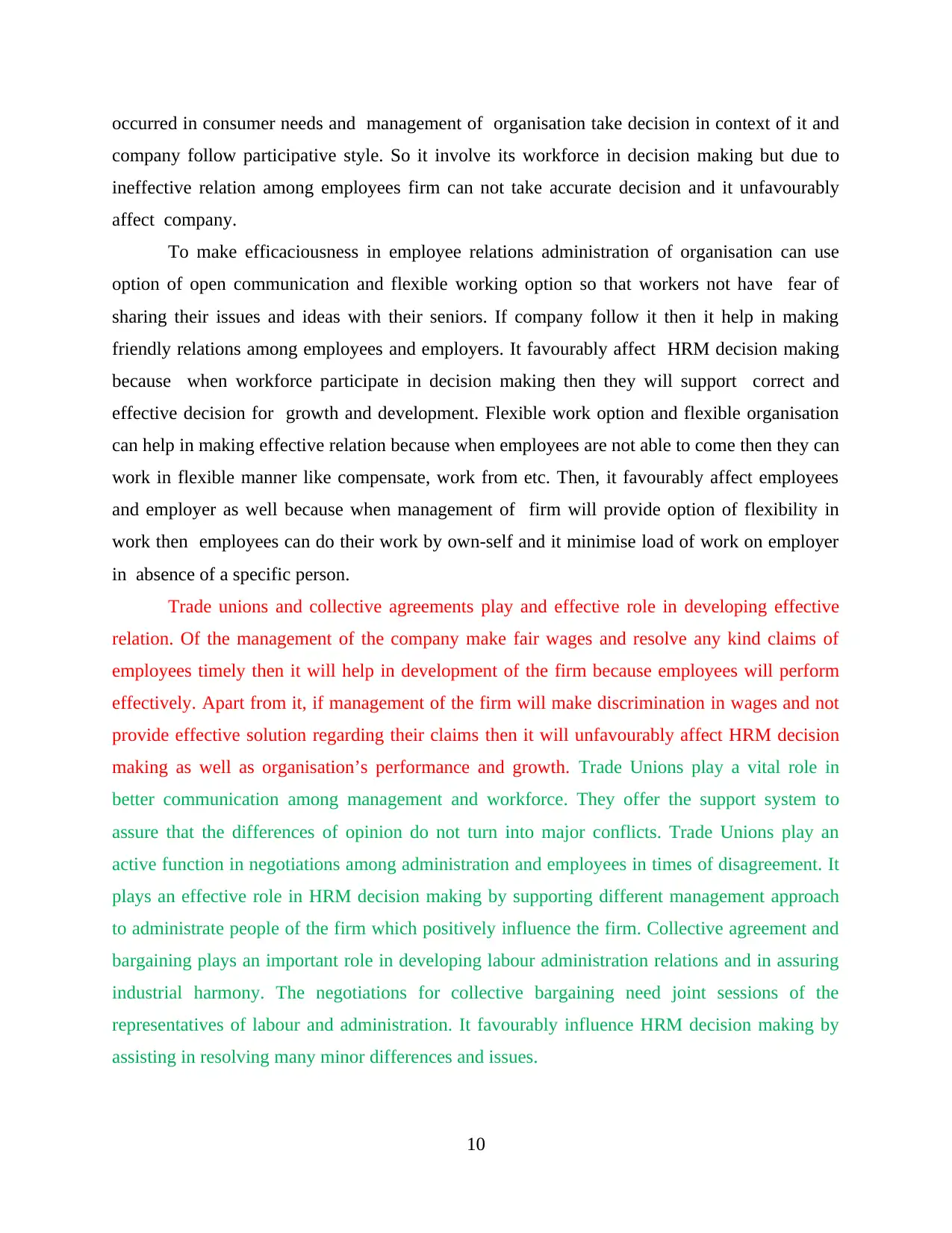
occurred in consumer needs and management of organisation take decision in context of it and
company follow participative style. So it involve its workforce in decision making but due to
ineffective relation among employees firm can not take accurate decision and it unfavourably
affect company.
To make efficaciousness in employee relations administration of organisation can use
option of open communication and flexible working option so that workers not have fear of
sharing their issues and ideas with their seniors. If company follow it then it help in making
friendly relations among employees and employers. It favourably affect HRM decision making
because when workforce participate in decision making then they will support correct and
effective decision for growth and development. Flexible work option and flexible organisation
can help in making effective relation because when employees are not able to come then they can
work in flexible manner like compensate, work from etc. Then, it favourably affect employees
and employer as well because when management of firm will provide option of flexibility in
work then employees can do their work by own-self and it minimise load of work on employer
in absence of a specific person.
Trade unions and collective agreements play and effective role in developing effective
relation. Of the management of the company make fair wages and resolve any kind claims of
employees timely then it will help in development of the firm because employees will perform
effectively. Apart from it, if management of the firm will make discrimination in wages and not
provide effective solution regarding their claims then it will unfavourably affect HRM decision
making as well as organisation’s performance and growth. Trade Unions play a vital role in
better communication among management and workforce. They offer the support system to
assure that the differences of opinion do not turn into major conflicts. Trade Unions play an
active function in negotiations among administration and employees in times of disagreement. It
plays an effective role in HRM decision making by supporting different management approach
to administrate people of the firm which positively influence the firm. Collective agreement and
bargaining plays an important role in developing labour administration relations and in assuring
industrial harmony. The negotiations for collective bargaining need joint sessions of the
representatives of labour and administration. It favourably influence HRM decision making by
assisting in resolving many minor differences and issues.
10
company follow participative style. So it involve its workforce in decision making but due to
ineffective relation among employees firm can not take accurate decision and it unfavourably
affect company.
To make efficaciousness in employee relations administration of organisation can use
option of open communication and flexible working option so that workers not have fear of
sharing their issues and ideas with their seniors. If company follow it then it help in making
friendly relations among employees and employers. It favourably affect HRM decision making
because when workforce participate in decision making then they will support correct and
effective decision for growth and development. Flexible work option and flexible organisation
can help in making effective relation because when employees are not able to come then they can
work in flexible manner like compensate, work from etc. Then, it favourably affect employees
and employer as well because when management of firm will provide option of flexibility in
work then employees can do their work by own-self and it minimise load of work on employer
in absence of a specific person.
Trade unions and collective agreements play and effective role in developing effective
relation. Of the management of the company make fair wages and resolve any kind claims of
employees timely then it will help in development of the firm because employees will perform
effectively. Apart from it, if management of the firm will make discrimination in wages and not
provide effective solution regarding their claims then it will unfavourably affect HRM decision
making as well as organisation’s performance and growth. Trade Unions play a vital role in
better communication among management and workforce. They offer the support system to
assure that the differences of opinion do not turn into major conflicts. Trade Unions play an
active function in negotiations among administration and employees in times of disagreement. It
plays an effective role in HRM decision making by supporting different management approach
to administrate people of the firm which positively influence the firm. Collective agreement and
bargaining plays an important role in developing labour administration relations and in assuring
industrial harmony. The negotiations for collective bargaining need joint sessions of the
representatives of labour and administration. It favourably influence HRM decision making by
assisting in resolving many minor differences and issues.
10
⊘ This is a preview!⊘
Do you want full access?
Subscribe today to unlock all pages.

Trusted by 1+ million students worldwide
1 out of 18
Related Documents
Your All-in-One AI-Powered Toolkit for Academic Success.
+13062052269
info@desklib.com
Available 24*7 on WhatsApp / Email
![[object Object]](/_next/static/media/star-bottom.7253800d.svg)
Unlock your academic potential
Copyright © 2020–2025 A2Z Services. All Rights Reserved. Developed and managed by ZUCOL.





